Why Won’t My Furnace Turn On? A Denver Tech Explains
Finding that your furnace is on the fritz mid-winter is every Denver homeowner’s nightmare.
But don’t worry, we’ll walk you through some easy DIY troubleshooting that just might save you money on a service call.
Some reasons your furnace won’t turn on include:
1) Problems with your thermostat
2) Problems with electrical power to the furnace
3) Fuel source problems
4) Condensate pan overflow switch problems
5) The flue gas spill switch shut the furnace off
We’ll show you what you can do to fix the problems above and get your furnace fired up ASAP.
Check your thermostat for these issues
Your thermostat “talks” to your furnace and tells it when to turn on and off. So, if your furnace isn’t kicking on when you expect it to, it’s likely that something’s preventing your thermostat from giving the “SEND HEAT” command to your furnace. If the thermostat is not set correctly or is not functioning properly, it can prevent the furnace from turning on.
Follow these thermostat troubleshooting steps:
1) Check that your thermostat has power. If the display is off, change the disposable batteries.
2) Check that the thermostat is set to HEAT. (You’d be surprised at how many homeowners don’t check this single switch before scheduling a service call.)
3) Turn up the set temperature to its highest setting and make sure that the thermostat is on RUN mode instead of HOLD or STANDBY mode (to turn off HOLD, press the RUN mode button).
If you’ve followed these steps but your furnace still won’t turn on, continue on to check for electrical issues.
Check for electrical power problems
Next, check to see if your furnace is actually getting the electrical power it needs to turn on. If there is a problem with the electrical system, it can prevent the furnace from turning on. This can be caused by a blown fuse, a tripped circuit breaker, or a malfunctioning thermostat.
To troubleshoot for electrical power issues, follow these steps:
1. Ensure that your furnace’s service switch is in the ON position. Depending on your furnace model, you may have several electrical power switches. Check for:
- An electrical power switch located on or near the unit itself
- An “emergency shut-off switch,” usually located right outside of a furnace room or basement
2. Locate the main electrical panel (usually in a basement, garage, outside or in a closet) and look for the circuit breaker labeled furnace or heat. Make sure the breaker switch is in the ON position.
3. If the circuit breaker is in the middle or the OFF position, press firmly to the ON position and check for power. Note: If the circuit breaker immediately pops back to the OFF position, leave the breaker alone and have a professional inspect the circuit breaker immediately.
Check that the inspection door is closed properly. Some modern furnaces have safety switches that detects an open access panel and will cut power to prevent fires.
Check that your gas-fired furnace is actually getting gas
If your furnace is a gas-fired furnace, you need to check your fuel source. Check that your gas is turned on and that the gas valves servicing your furnace are working properly.
Check your condensate pan overflow switch
If you have a high-efficiency furnace (90 AFUE or higher), it creates condensation. Usually the condensate pan (or “drain pan”) underneath your air handler catches and drains away all that moisture.
But if that system gets clogged and the pan overflows, the condensate pan overflow switch shuts off power to the air handler.
Note: not all condensate pans have a float switch. If your condensate pan doesn’t have a device installed similar to the one below, skip to the next section.
To check for this issue, follow these steps:
- Locate your indoor air handler (usually in an attic, basement or closet).
- Check the tray underneath the air handler. Remove any standing water. This should automatically restore power as the switch will now settle to the bottom of the pan, allowing for electrical power to flow to your air handler again.
- If the switch doesn’t reset after water is removed from the tray, have a professional inspect the switch. It may need to be replaced.
Check your flue gas spill switch
Gas-fired furnaces can potentially leak dangerous gases, like carbon monoxide, into your home. Newer furnaces have “flue gas spill” switches that prevent this leakage from harming your family. In other words, if this switch senses that flue gases aren’t properly venting into the outdoor air, the switch will cut power to the furnace.
To check this switch, follow these steps:
- Locate the switch (usually on the furnace draft hood).
- If the switch is in the safety OFF position, call a professional immediately. Don’t attempt to reset this button. If the switch is off, it’s off for a reason. Resetting it could allow more dangerous gases into your home.
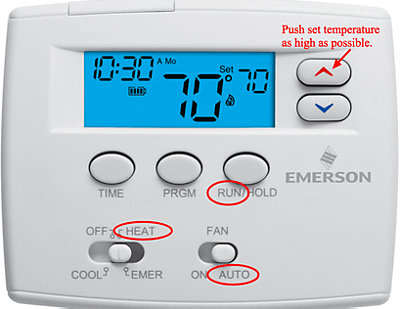
Check that your thermostat mirrors these settings. Source: emersonclimate.com
If you’ve followed these steps but your furnace still won’t turn on, continue on to check for electrical issues.
Check for electrical power problems
Next, check to see if your furnace is actually getting the electrical power it needs to turn on.
To troubleshoot for electrical power issues, follow these steps:
1) Ensure that your furnace’s service switch is in the ON position. Depending on your furnace model, you may have several electrical power switches. Check for:
a) An electrical power switch located on or near the unit itself
b) An “emergency shut-off switch,” usually located right outside of a furnace room or basement
2) Locate the main electrical panel (usually in a basement, garage, outside or in a closet) and look for the circuit breaker labeled furnace or heat. Make sure the breaker switch is in the ON position.
3) If the circuit breaker is in the middle or the OFF position, press firmly to the ON position and check for power. Note: If the circuit breaker immediately pops back to the OFF position, leave the breaker alone and have a professional inspect the circuit breaker immediately.
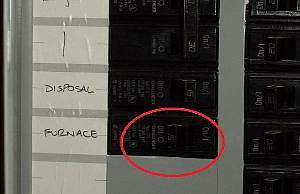
Your furnace will have its own circuit breaker at the main panel. Make sure it’s in the ON position.
Source
4) Check that the inspection door is closed properly. Some modern furnaces have safety switches that detects an open access panel and will cut power to prevent fires.
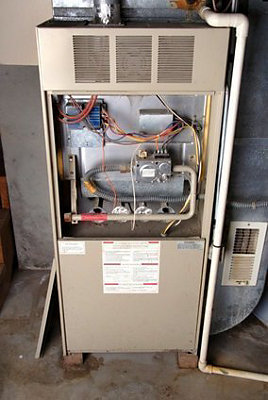
An open access panel (shown here) will prevent some modern furnaces from starting.
Source: npihome.com
Check that your gas-fired furnace is actually getting gas
If your furnace is a gas-fired furnace, you need to check your fuel source. Check that your gas is turned on and that the gas valves servicing your furnace are working properly.
Check your condensate pan overflow switch
If you have a high-efficiency furnace (90 AFUE or higher), it creates condensation. Usually the condensate pan (or “drain pan”) underneath your air handler catches and drains away all that moisture.
But if that system gets clogged and the pan overflows, the condensate pan overflow switch shuts off power to the air handler.
Note: not all condensate pans have a float switch. If your condensate pan doesn’t have a device installed similar to the one below, skip to the next section.
To check this issue, follow these steps:
- Locate your indoor air handler (usually in an attic, basement or closet).
- Check the tray underneath the air handler. Remove any standing water. This should automatically restore power as the switch will now settle to the bottom of the pan, allowing for electrical power to flow to your air handler again.
- If the switch doesn’t reset after water is removed from the tray, have a professional inspect the switch. It may need to be replaced.
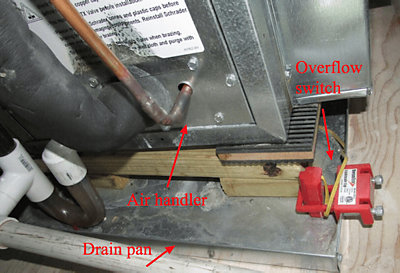
Check your flue gas spill switch
Gas-fired furnaces can potentially leak dangerous gases, like carbon monoxide, into your home. Newer furnaces have “flue gas spill” switches that prevent this leakage from harming your family. In other words, if this switch senses that flue gases aren’t properly venting into the outdoor air, the switch will cut power to the furnace.
To check this switch, follow these steps:
- Locate the switch (usually on the furnace draft hood).
- If the switch is in the safety OFF position, call a professional immediately. Don’t attempt to reset this button. If the switch is off, it’s off for a reason. Resetting it could allow more dangerous gases into your home.
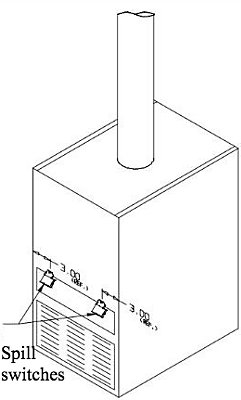
Furnace still not turning on? Call a Denver HVAC pro
If you’ve checked for all the issues above, you’ve exhausted your DIY efforts and need to call in a professional heating contractor.
Luckily, if you live in Denver or the surrounding areas, experienced and reliable HVAC techs are just a phone call away. We provide professional heating and furnace repair service you can count on.
Schedule your appointment with Plumbline today and we’ll get your furnace working in no time.
Related reading:
Need help from a Colorado Plumbing, Heating, Cooling, or Electrical Specialist?
For your convenience, you can request an appointment in one of two ways:
- Call us at (303) 436-2525 for immediate assistance.
- Click on the button below to schedule your appointment online.
Related Reading
Join Our Email Newsletter
Receive updates, current news, promotions, and industry tips.
